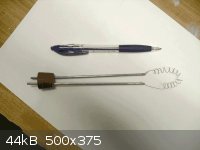FrankMartin
Hazard to Self
 
Posts: 50
Registered: 30-5-2010
Member Is Offline
Mood: No Mood
|
|
Small resistance heater. Problem
I have made a small resistance heater from BS28 nichrome wire connected to electrodes of 316LSS.
It is connected to a DC power supply at 3 amps, approx 13Volts.
It heats water OK, but there is a brown ppt thrown down and the nichrome wire corrodes badly (ie pitted) after about half an hour.
Why does this happen? Please help.

|
|
|
m1tanker78
National Hazard
   
Posts: 685
Registered: 5-1-2011
Member Is Offline
Mood: No Mood
|
|
My money would be on the electrodes coughing up iron. Try using distilled water. Your nichrome pigtail is essentially a resistor so you have a
significant voltage drop coupled with water that contains ions which make it somewhat conductive.
Electrolysis...
If you insist on using tap water or similar, AC might prolong the life of the heater a bit. Even a tiny bit of iron makes an alarmingly voluminous
precipitate.
Tank
|
|
|
FrankMartin
Hazard to Self
 
Posts: 50
Registered: 30-5-2010
Member Is Offline
Mood: No Mood
|
|
Thanks. I made the heater to fit down a B19 flask socket to reflux organic liquids without bumping. Ordinary electric kettles of the older variety
do not have corroding elements, so perhaps the DC is the problem.
|
|
|
Mr. Wizard
International Hazard
    
Posts: 1042
Registered: 30-3-2003
Member Is Offline
Mood: No Mood
|
|
What is happening is electrolysis of the heating element. The voltage drop across the resistance wire is 13 volts, so the electrical potential
between the resistance wire where it contacts the water is 13 volts. There is a voltage potential at every point on the resistance wire to every other
point. AC will not change this. You are not thinking of the wire as electrodes, but they are when in an electrolyte.
What you need is to keep the electrode away from any conducting electrolyte, and still provide a place for the 39 watts of heat to escape. Failure to
remove the heat will result in the resistance wire increasing in temperature and either melting or limiting the heat delivered.
|
|
|